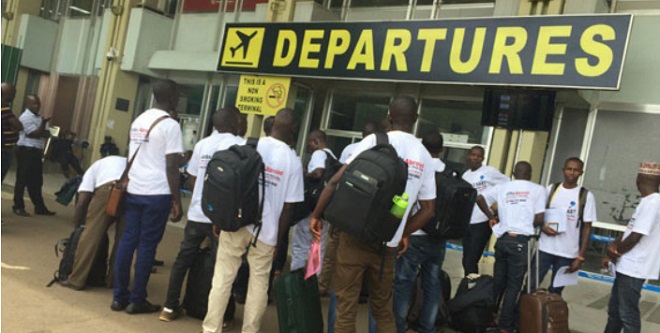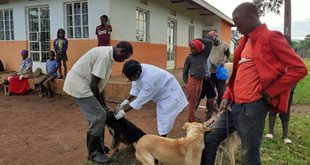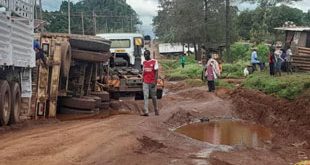
COMMENT | Martin Sabiiti | According to the Uganda Association (UAERA) for External Recruitment Agencies there are over 140,000 Ugandans working in the Middle East. The number could even be higher when you factor in those who are trafficked and can’t be properly accounted for.
The story of labour export has been dominated by the mistreatment and even death of Ugandan girls who work as maids. One may be tempted to think Uganda only exports maids to the Middle East.
To the contrary Uganda exports about 10 categories of labourers to the Middle East namely; professionals, technicians, skilled, semi-skilled, security personnel, porters, drivers, cleaners, housekeepers and catering and hospitality personnel.
These earn salaries which range from sh800,000/= to sh5M per month depending on the job and qualification.
Close to where I work in Old Kampala there is a medical centre which is frequented by many youth seeking medical reports to use in securing their travel to Middle East for green pastures.
Taxis, super customs and all sorts of vehicles bring on a daily basis especially girls for checkup. Many of the girls brought here look emaciated but full of hope of the prospect that life is going to be better when they finally secure employment in the Arab world.
Fortunately for many who are already there life has indeed improved if the documentaries on TV from some consultants are anything to go by.
Construction sites dominate the documentaries I have watched in a bid to attract more to go and work.
Three sample success stories will reveal to you how real estate is the number one preference for most of these youths.
Hajji Katende whose children are working in the Middle East reveals that his first son Hadadi Katende, who was the first to go, has already built a plush residential house. Nalubega who has been working in Qatar for three years began constructing rental houses in December 2018 as well as Abdu Katumba who is working in Dubai for the last two years.
What is of concern though is a good number of those featured in the documentaries are village residential homes of not more than three bedrooms. That aside the catch in this is that most of them invest in real estate ranging from houses and plots with a few opting for business.
This means that as a country we can come up with a program to organize these youths and help them invest in real estate as a group.
National Housing for example can come up with affordable housing projects for them.
The youths can be asked to sign up for housing units depending on their monthly pay and length of their contracts before they board a plane. This will mean that those who sign will have to forfeit a proportion of their monthly income towards the payment for the unit.
For example a youth earning sh2 million a month makes sh48 million in two years. He or she can sign off 1 million monthly towards a housing unit making of total of 24 million shillings in two years.
This will give purpose to their inconvenient and tough life in the desert of United Arab Emirates and also lead to the growth of the real estate industry in Uganda.
A simple scan through the apartments market will show you that on a competitive market platform you can get a condominium apartment at sh90 million.
This means that with a ready market, commitment and numbers it is possible for National Housing to build affordable houses for these youths.
It is something worth looking into by national housing and Construction Company and the government of Uganda. An architect I talked to recently confirmed to me that one can build a two bed-roomed house at a cost of Shs25m on a 50ft by 50ft plot.
Just last year the president of Kenya Uhuru Kenyatta in his speech, promised that through the delivery of 1 million housing units, half a million more Kenyans will own homes by the end of his second term in the year 2022.
Out of these units, 800,000 will be affordable houses costing between Kshs 0.8 mn (Ugx 28M) and Kshs 3.0 mn (Ugx105M) and 200,000 will be social housing units costing between Kshs 0.6 mn (Ugx21M) and Kshs 1.0 mn (Ugx35M), according to the Big 4 Agenda Blueprint.
Singapore is said to be a country with one of the best housing solutions in the world.
In 1960, just after acquiring independence, Singapore had a cumulative housing requirement of 147,000 units for the 10-year period that ended in 1969 for a population of 1.6 million people, which was growing at 6.4% per annum.
The private sector only had the ability to provide 2,500 units per year and at price levels out of reach for the low-income segment.
The government, therefore, put in place policies and strategies to promote home-ownership for its residents.
Currently, according to the World Bank, 80.0% of Singaporeans live in houses built by the government, through the Housing Development Board (HDB) (the equivalent of the National Housing Corporation in Uganda), with 90.0% being owner-occupied, yet when they attained self-government in 1959 only 9.0% lived in public housing.
This is one of the many lessons Uganda under Museveni can learn from Singapore under Lee Kuan Yew considering that at independence Singapore was at the same level as Uganda. Singapore has since left us.
******
 The writer is Head of Business Development at Uganda National Chamber of Commerce and Industry currently. I am a Financial Literacy Trainer by Bank of Uganda.
The writer is Head of Business Development at Uganda National Chamber of Commerce and Industry currently. I am a Financial Literacy Trainer by Bank of Uganda.
 The Independent Uganda: You get the Truth we Pay the Price
The Independent Uganda: You get the Truth we Pay the Price


